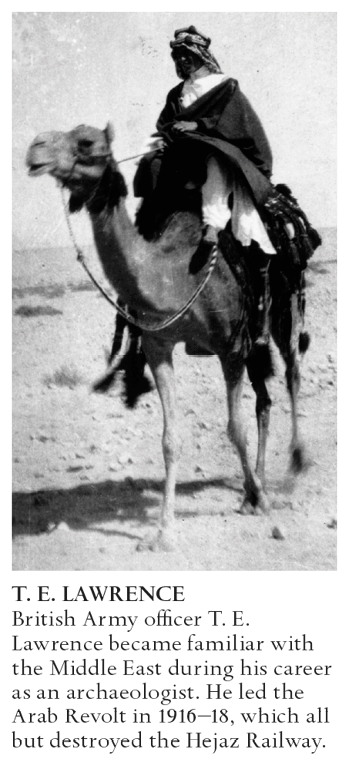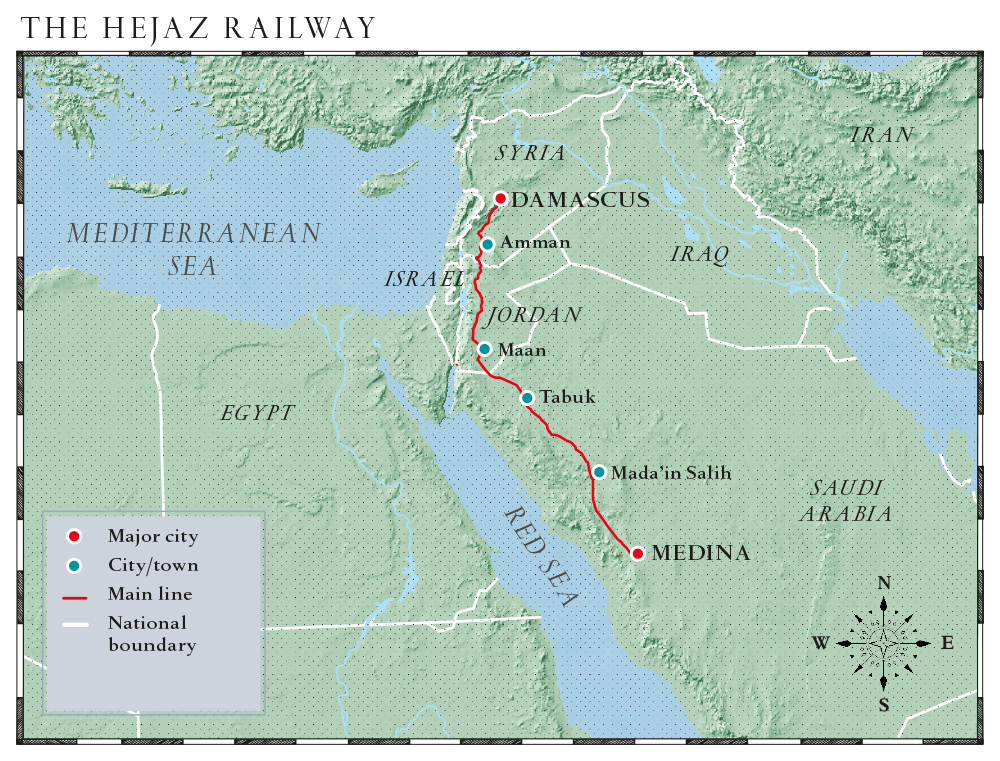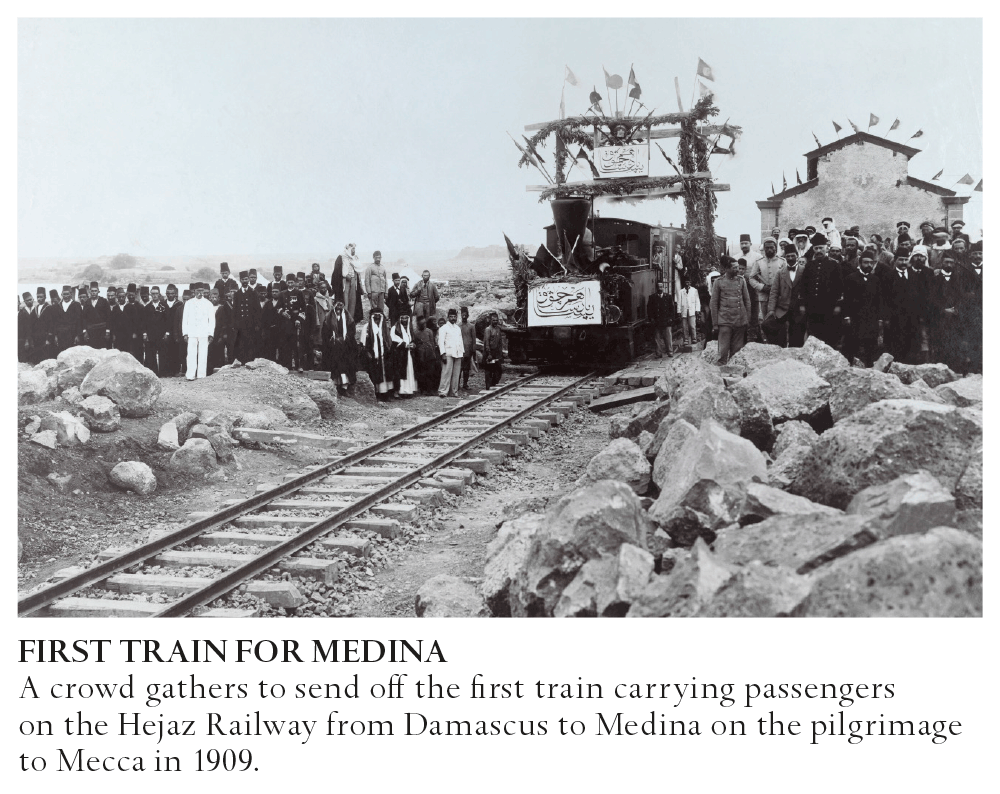Railroads came late to the Middle East. By the end of the 19th century, there were just a few lines operating in the crumbling Ottoman Empire. Their military and political value had been recognized by far-sighted rulers, however, and this was the catalyst for the construction of a railway deep in the desert of the Hejaz region of what is now Saudi Arabia—a line that would be made famous in the West by Lawrence of Arabia.

As with many pioneering railroads, the idea for its construction was mooted long before work commenced. German-American civil engineer Charles Zimpel proposed a line from Damascus to the Red Sea in 1864, and numerous similar lines were also suggested in the last third of the 19th century. However, it was the proposal in 1897 by Muhammad Insha Allah, an Indian Muslim teacher and journalist, that attracted the attention of the Sultan of the Empire, Abdulhamid II.
Abdulhamid was the conservative leader of the failing Ottoman Empire, ruling from Constantinople (now Istanbul). Soon after his accession, in 1876, the empire had lost two fifths of its territory, including European holdings such as Bulgaria and Greece, effectively ending Ottoman influence in Europe. Following this loss, the Sultan resolved to strengthen his hold over the remaining Asian part of the empire, which included the Arabian Peninsula. The political influence of the empire was waning, but Abdulhamid hoped to reinforce its religious significance. The proposed railroad offered an opportunity to consolidate his own position as Caliph, leader of all Muslims: the new line would ensure a fast, cheap way for pilgrims to travel to Mecca. Funding for the railroad was obtained largely through Muslim support due to its religious significance.

Work started on the 4ft 1111⁄16in- (1,500mm-) gauge railroad in late 1900 under the auspices of a German engineer, Heinrich Meissner, who drove the project for eight years. Initially, it was beset by problems and progress was slow. The original surveys were unsatisfactory and had to be redone. The laborers, mostly conscripts, worked in appalling conditions—poor treatment that resulted in a mutiny. Recognizing the lack of progress, the Sultan took a softer approach and Meissner began to impose a more acceptable regime, attracting experienced foreign workers from Belgium, France, and Germany in particular. In the later stages, however, Christians were not allowed to work on the southern end of the railroad because of religious sensibilities, but by then trained Turkish Muslim engineers were available.
Three teams were created: for reconnoitring, surveying, and construction. The reconnoitring team, which made a preliminary assessment of the route, experienced the most difficulties: they went into the desert mounted on camels and horses, venturing into unmapped land and facing hostile tribes, and so were accompanied by a cavalry detachment. The second team, the surveyors, used the maps created by the reconnoitring group to set out a detailed route for the construction gangs to follow. Construction was carried out by a special railroad battalion with four divisions, each one focused on a particular task: the advance party marked out a trace for the track and prepared the earthworks; the second division put down the ballast; the ties were laid by the third group; and the rails were laid in by the fourth.
Such a disciplined and organized process allowed rapid progress despite the difficulties of the terrain and other obstacles. It was not just the heat, which could reach 122ºF (50°C) in the middle of the day (matched by cold nights in winter), or the remoteness of the land, but the sheer scale of the operation: 1,000 miles (1,600km) of track had to be laid to reach the original target—the holy city of Islam, Mecca.
The scarcity of water was the worst problem faced by the builders of the line, which followed old pilgrimage trails. These had occasional wells and pools where rainwater collected, but, for the most part, the vital liquid was stored in cisterns installed along the line and replenished by tank cars transported down the newly constructed railroad. While lack of water was a perennial problem, ironically flash floods washed away parts of the line in the rainy season. To limit such damage, many sections of the railroad were built on embankments.
Sand drifts across the tracks were another obstacle. When construction reached the desert of the southern Arabian Peninsula, there was little vegetation to prevent sand being driven onto the railroad by the wind, and it was therefore necessary for the line to be protected by sandbanks made of stone and clay.

The greatest irony was the shortage of fuel. Coal mined in Turkey proved too smoky, and so fuel was imported from Wales at great expense, then mixed with the local coal. Since steam locomotives can run on oil, the solution was in fact near at hand. As James Nicholson, author of the line’s history, puts it, “In view of the fact that the Ottomans at that time also controlled the Eastern Province of what is now Saudi Arabia, they would have been surprised to discover just how easily all their fuel needs could have been met by what lay beneath the sands.”
The workers, who numbered 7,000 at the peak of construction, lived in small tents that had to be moved forward constantly as the line progressed. Laborers lived on a diet of bread, cookies, or rice with only occasional additions of meat. There were no fresh vegetables or fruit, so vitamin deficiency diseases, such as scurvy, were common. Cholera outbreaks were not unusual and caused widespread panic, with workers fleeing the camps, which delayed progress.
As the railroad approached Medina, plans were still in place to extend the line to Mecca. However, opposition to what was called “the iron donkey” was strong among the local tribes, who did not want to see it reach Mecca. Their objections were not solely stimulated by religion: many local tribesmen made their living from operating the camel caravans for pilgrims. This resistance culminated in a revolt in January 1908, when Abdulhamid’s political position was already weak. As a result the planned extension of the line to Mecca was scrapped. Instead, Medina, the second holiest city in Islam, became its terminus.

The last stretch of track from Al-‘Ula to Medina was the most difficult to lay in terms of the terrain, but work speeded up with the arrival of extra workers. The rapid conclusion of the project was partly to ensure that the line’s opening coincided with the anniversary of the Sultan’s accession to the throne on September 1, 1908. The deadline was met and there were celebrations in Medina, but the Sultan did not attend: his popularity was by this time so low that he feared his absence from Constantinople might result in a coup.
Despite the Sultan’s mounting political difficulties, the Hejaz Railway enjoyed eight years of normal operations, carrying many thousands of pilgrims to and from Medina. However, the line’s fate was always bound up with regional and, indeed, global political considerations, and World War I was to turn the railroad into a battleground.
The Ottoman Empire entered the war in 1914 on the side of the Germans. The British were keen to ensure that the Turks did not launch attacks elsewhere, and so encouraged the Arabs in the Peninsula to rise against them. The Hejaz Railway was an obvious target and in June 1916 the tribes began attacking the line. However, the Arabs needed explosives and better equipment, and that is where T. E. Lawrence—Lawrence of Arabia—entered the fray. Despite ranking only as captain and holding a desk job in Cairo, he persuaded his superiors to send him across the Suez Canal to support the uprising led by Prince Feisal, one of the sons of Sharif Hussein, the Emir of Mecca.
Feisal’s irregular troops had already launched several successful attacks on the line when Lawrence joined them in early 1917. He led several more raids, both attacking trains and sabotaging the track. The strategy, an early use of guerrilla tactics, was not to close the line, but rather to tie up Turkish troops in its protection. Very few of Lawrence’s troops were killed in these raids—depicted so powerfully in the David Lean film Lawrence of Arabia—but thousands of Turks lost their lives and the strategy proved successful. Gradually, Lawrence and Feisal worked their way up the line and gained control of the railroad as the Turks fled north. This meant that Medina, and the Turkish troops defending it, were cut off from the rest of the Ottoman forces.

Lawrence and Feisal eventually joined up with the British forces under General Allenby for a final assault on Damascus. Feisal’s army, which included Lawrence, was given the task of cutting off the junction that led from the Syrian city of Daraa to the Mediterranean port of Haifa (now in Israel). The last, decisive attack on the Turks in Damascus in September 1918 was successful, but Medina was still occupied by Turkish troops who did not surrender until January 1919, arguably the last action of World War I.
As Lawrence recognized in his account of the battle over the Hejaz, Seven Pillars of Wisdom, the Turks were courageous and became adept at repairing the line. Following the war, and the division of the Ottoman Empire into states under British or French control, the operation of the line was split between the two European colonial powers. The Allies and the retreating Turks had destroyed much of the southern section of the railroad, but several parts remained open for traffic.
The best-used sections were freight services on the branch line between Damascus and Haifa and, until the start of the Syrian conflict, there was a passenger train from Damascus to Amman (the capital of Jordan). Saudi Arabia is also building a new network of lines to cater for the Haj and its freight needs, and there has even been talk of reopening the entire Hejaz Railway, but this may prove too expensive, and unnecessary now that many pilgrims travel to Mecca by air.
The eight years from 1908 to 1916 were to be the only time at which regular services operated along the whole railroad. Even then, conditions were uncomfortable for the pilgrims, as services were overcrowded and slow. The journey, however, which took just over a day, was a vast improvement on the old 40-day overland trip. It proved a brief heyday for one of the world’s most ambitious railroad construction projects.